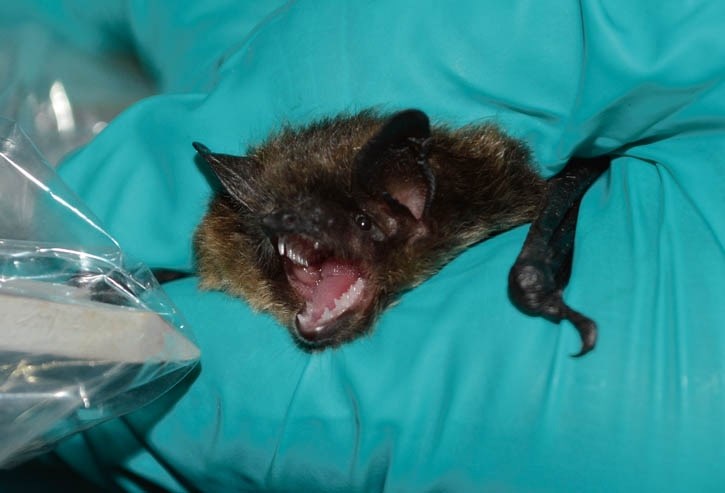Bats, including the endangered little brown bat, have been found in the Nakimu cave system in Glacier National Park.
Over an 18-month period in 2013 and 2014, acoustic monitors recorded bat calls from little brown bat and long-eared myotis, plus at least three other species. It’s believed the bats are using smaller cave entrances for swarming, and possibly using caves as a hibernaculum.
Officials say the bats are healthy and there’s no evidence of white-nose syndrome in the little brown bat, a deadly fungal disease that has killed off millions of hibernating bats, including the little brown.
“We wanted to identify if we had bats in Nakimu cave because previously there was no anecdotal evidence of bats in the cave at all,” said Sarah Boyle, an ecologist with Mount Revelstoke and Glacier national parks.
“People who worked here for 30 years swore there were no bats there, but I had a feeling that just because we didn’t see them didn’t mean they are not there. We set out to find them with this new technology, and sure enough, we have bats.”
Acoustic recordings picked up 28,000 bat calls. Bats were detected in four of six cave entrances and outside two entrances, with the activity highest between late July and mid-September.
The vast majority of the bats were little brown bats, with some long-eared myotis detected as well. The three others bat species included California myotis or Yuma myotis, silver-haired and/or big brown bats, with the possibility of northern myotis and long-legged myotis.
Boyle said the recording quality could not confirm the latter two and additional research, such as mist netting captures, is required to confirm their presence.
“The technology is good enough to let us know we had bats, but if bats have similar frequencies, we can’t differentiate,” she said.
To get a visual on the bats, researchers this year set up mist nets – typically made of nylon or polyester mesh suspended between two poles, resembling a volleyball net – to capture the bats.
Researchers captured several little brown bats, including three adult male bats and one female. The bats were examined, had DNA collected and then quickly released back into the wild.
Additional nets will be put up again next summer to accurately identify the other four bat species in the cave system.
“The little brown bat was the only species we caught in the mist nets,” said Boyle.
Researchers will remove the bat acoustic recorders presently at the site as soon as weather allows, and then deploy additional bat monitors at the cave system in March.
Boyle said patterns of activity suggest bats use the caves as swarming sites, and possibly for hibernation, but they can’t say for sure yet if the bats are in fact hibernating there.
“We had suspected it was used a swarming site, where it’s a hookup joint for bats, because we saw these bats ready to reproduce,” she said.
“If we find we have bat calls at this time of year, at a time when they go into hibernation, and then have bat calls close to when they emerge, then we can be fairly confident they’re using the site for hibernation.”
Boyle said bats they captured appeared very healthy, though one bat had a parasite in its ear.
She said there was no sign of white-nose syndrome.
“We can confirm that the Nakimu cave system in Glacier National Park does not have white-nose syndrome,” Boyle said. “They are really healthy bats. They had good weights, were really feisty, had really shiny fur and were really beautiful.”
White-nose syndrome was first discovered in a cave in New York State in 2006. The deadly disease hit Eastern Canada in the winter of 2009-2010 and has since been documented in the eastern United States and five eastern provinces in Canada.
Experts predict it is only a matter of time before it reaches the western parts of Canada.
A white fuzzy fungal growth is seen around the nose and on the wings of infected bats. The disease interrupts the hibernation of bats and they quickly use up fat reserves that get them through winter.
Infected bats often emerge earlier from hibernation than they should and are seen flying around midwinter. These bats usually dehydrate or starve to death.
Boyle said the Nakimu cave system is already a restricted area, whereby only people with permits can enter the area.
“Typically, only caving groups want to get in and they go through a very rigorous process to get through their application,” she said.
“Now with white-nose syndrome in North America, we have put in very strict disinfection protocols and we will audit people to make sure they are disinfecting properly.”
If bats are found to hibernate at the Nakimu cave system, there is a chance the cave will be closed in winter.
“Right now, the cave is open for year-round access, but if we confirm bats are hibernating there, we may adjust the access and not allow access in winter so as not to disturb hibernating bats,” said Boyle.
Bats play an important role in nature, with most species consuming vast amounts of insects, including many insects that can be damaging to agriculture.
“They can eat their body weight in insects overnight and are part of a healthy ecosystem,” said Boyle. “They are a cryptic and unknown species – and they’re fascinating.”




